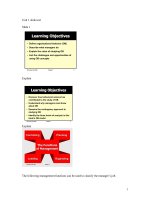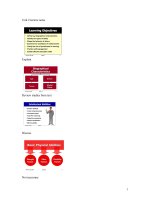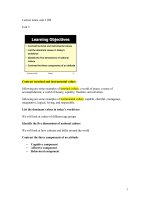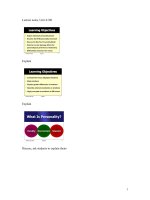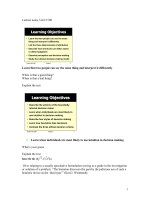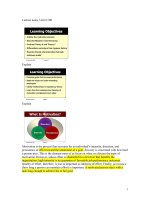Organizational behavior: Lecture 31 - Dr. Mukhtar Ahmed
Bạn đang xem bản rút gọn của tài liệu. Xem và tải ngay bản đầy đủ của tài liệu tại đây (772.39 KB, 60 trang )
Organizational
Behavior
(MGT-502)
Lecture-31
Summary
of
Lecture-30
Characteristics Common
to All Organizations
Hierarchy of
authority
Division of
labor
Coordination
of effort
Common
goal
Organizational Structure
and Design
• Organizational Structure
– The formal pattern of how people and
jobs are grouped in an organization.
• Organizational Design
– The decisions and actions that result in
organizational structure.
Organization Structure: Its
Determinants and Outcomes
Causes
•Strategy
•Size
•Technology
•Environment
determines
Structural
designs
•Mechanistic
•Organic
Moderated by
Individual
Differences
leads to
Performance
and
Satisfaction
Six Key Questions That Managers Need
to Answer in Designing the Proper
Organizational Structure
The Key Question
The Answer
Is Provided By
1. To what degree are tasks subdivided into
separate jobs?
Work specialization
2. On what basis will jobs be grouped
together?
3. To whom do individuals and groups report?
Departmentalization
4. How many individuals can a manager
efficiently and effectively handle?
Span of control
5. Where does decision -making authority lie?
Centralization and
decentralization
6. To what degree will there be rule and
regulations to direct employees and
managers?
Formalization
Chain of command
Organizational Design
Components
Components
Division of
Labor
Authority
Departmentalization
Span of
Control
Design Decisions
Specialization
High
Low
Delegation
High
Low
Basis
Homogenous
Heterogeneous
Number
Few
Many
Organizational Design Models
The Mechanistic
Model
The Organic
Model
The Matrix
Model
Organization
Size
Strategy
Why Do
Structures
Differ?
Technology
Environment
Today’s Topics
The Basics of Organizational
Structure
• Organizational structure defines how
job tasks are formally divided,
grouped, and coordinated.
• The organization chart is a visual
representation of this division,
grouping, and coordination.
Designing an Organization
Structure
Basic Steps
1.
Managers must decide how to divide the overall tasks
of the organization into successively smaller jobs.
2.
Managers must decide the basis by which to
group the individual jobs.
3.
Managers must decide the appropriate size of the
group reporting to each supervisor
4.
Managers must distribute authority among the jobs.
Three Types of Relationships:
• Direct single
– Between a manager and each subordinate
individually
• Direct group
– Between a manager and each possible
permutation of subordinates
• Cross
– Between subordinates and other
subordinates
Three Types of Authority
Line Authority
Defines the relationship between
superior and subordinate.
Staff Authority
Is the authority to serve in an
advisory capacity.
Functional
Authority
Permits staff managers to make
decisions about specific activities
performed by employees within other
departments.
Elements of
Organizational Structure
Departmentalization
Span of
Control
Organizational
Structure
Elements
Formalization
Centralization
Common
Organizational Design
• Simple Structure
• Bureaucracy
• Matrix Structure
Simple Structure
A structure characterized by a low
degree of departmentalization,
wide spans of control, authority
centralized in a single person,
and little formalization.
The Simple Structure
Abid’s Store
Abid
Owner,
manager
Farooq
salesperson
Sajjad
salesperson
Shakir
salesperson
Rafiq
Riaz
salesperson
Cashier
Few
Departments
Wide Spans
of Control
The Simple Structure
Little
Formalization
Centralized
Authority
Bureaucracy
A structure with highly routine operating tasks
achieved through specialization, very
formalized rules and regulations, tasks that are
grouped into functional departments,
centralized authority, narrow spans of control,
and decision making that follows the chain of
command.
The
Bureaucracy
Functional
Structure
Divisional
Structure
The Bureaucracy
• Strengths
– Functional
economies of scale
– Minimum duplication
of personnel and
equipment
– Enhanced
communication
– Centralized decision
making
• Weaknesses
– Subunit conflicts
with organizational
goals
– Obsessive concern
with rules and
regulations
– Lack of employee
discretion to deal
with problems
Matrix Structure
A structure that creates dual lines
of authority and combines
functional and product
departmentalization.
The Matrix Structure
Cross-Functional
Coordination
Clear
Accountability
Dual Chain
of Command
Allocation
of Specialists
Choosing an
Appropriate Structure
• A structure should be chosen that best
supports the organization’s strategy.
• There are trade-offs in any choice of
structure.
• After the strategic priorities are noted,
however, this should help determine which
tradeoffs to make.


